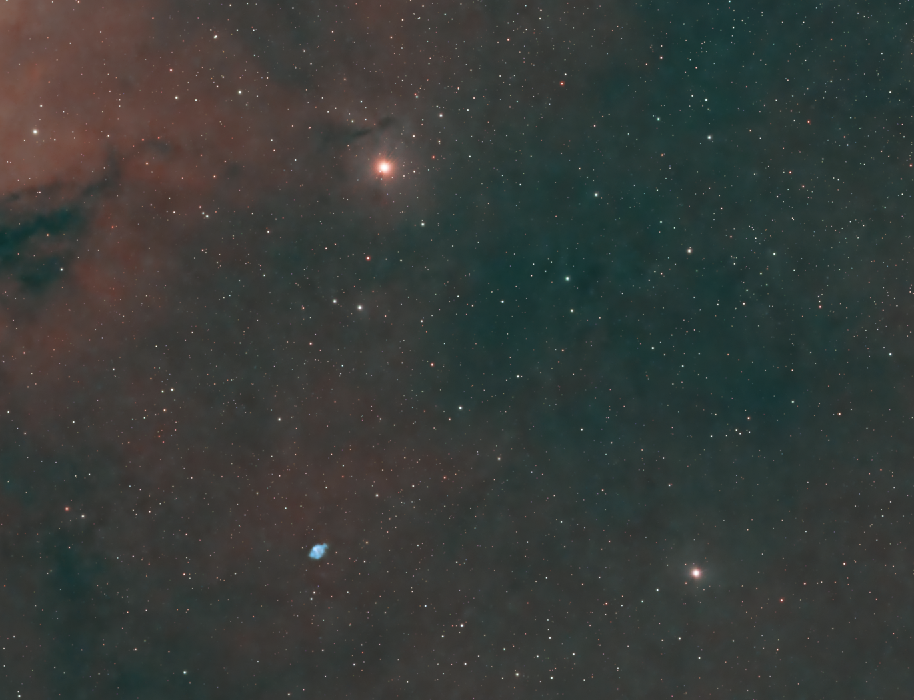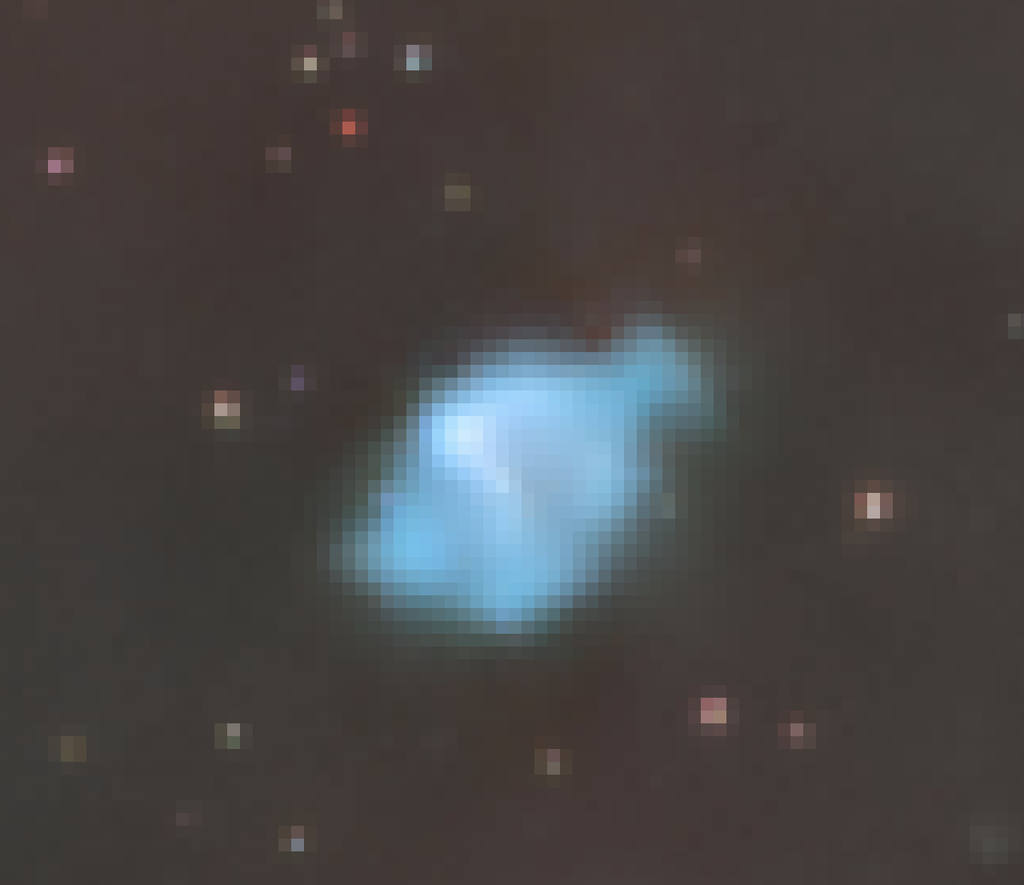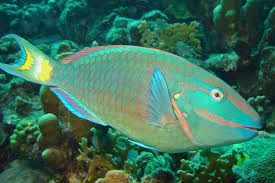Does anyone know what the blue object below the Garnet Star in the Elephant Trunk Nebula (IC 1396) is? This is with Ha-OIII narrowband and I have increased the saturation of the blue a bit so it is actually probably more of a blue-white colour. I presume it is a reflection nebula? This is a 327mm focal length with an ASI2600 so the pixels are 2.36" in size so the object is maybe 60 arcsecs across?   |
You cannot like this item. Reason: "ANONYMOUS".
You cannot remove your like from this item.
Editing a post is only allowed within 24 hours after creating it.
You cannot Like this post because the topic is closed.
Copy the URL below to share a direct link to this post.
This post cannot be edited using the classic forums editor.
To edit this post, please enable the "New forums experience" in your settings.
You cannot like this item. Reason: "ANONYMOUS".
You cannot remove your like from this item.
Editing a post is only allowed within 24 hours after creating it.
You cannot Like this post because the topic is closed.
Copy the URL below to share a direct link to this post.
This post cannot be edited using the classic forums editor.
To edit this post, please enable the "New forums experience" in your settings.
andrea tasselli:
GM 3-13, a PN. Lovely. Thanks.
|
You cannot like this item. Reason: "ANONYMOUS".
You cannot remove your like from this item.
Editing a post is only allowed within 24 hours after creating it.
You cannot Like this post because the topic is closed.
Copy the URL below to share a direct link to this post.
This post cannot be edited using the classic forums editor.
To edit this post, please enable the "New forums experience" in your settings.
Thanks @andrea tasselli That identification got me to this thread: https://www.cloudynights.com/topic/846834-gm-3-13-planetary-nebula-in-cepheus/ which suggests (after some back and forth) that it may be PM 1-333
|
You cannot like this item. Reason: "ANONYMOUS".
You cannot remove your like from this item.
Editing a post is only allowed within 24 hours after creating it.
You cannot Like this post because the topic is closed.
Copy the URL below to share a direct link to this post.
This post cannot be edited using the classic forums editor.
To edit this post, please enable the "New forums experience" in your settings.
Or possibly https://app.astrobin.com/i/0dolq1 " In SIMBAD, this object is known as PN G100.4+04.6 (a “possible planetary nebula”), while in NED it is surprisingly known slightly differently as PN G100.5+04.7" Anyway, a nice little gem.
|
You cannot like this item. Reason: "ANONYMOUS".
You cannot remove your like from this item.
Editing a post is only allowed within 24 hours after creating it.
You cannot Like this post because the topic is closed.
Copy the URL below to share a direct link to this post.
This post cannot be edited using the classic forums editor.
To edit this post, please enable the "New forums experience" in your settings.
The last two refer to the PN's galactic coordinates so little surprise in a slight difference in the PN/s coordinates (which may either identified by the originator white dwarf or its photometric barycentre)
|
You cannot like this item. Reason: "ANONYMOUS".
You cannot remove your like from this item.
Editing a post is only allowed within 24 hours after creating it.
You cannot Like this post because the topic is closed.
Copy the URL below to share a direct link to this post.
This post cannot be edited using the classic forums editor.
To edit this post, please enable the "New forums experience" in your settings.
Yes - Simbad has the following: At coords (J2000.0) 21:40:59.32176 +58:58:38.7768:
Object: IRAS 21394+5844 (Planetary Nebula)
Distance from query: 20.80 arcsec
Other Identifiers:
- PN G100.4+04.6
- IRAS 21394+5844
- PK 100+04 1
- PN PM 1-333
- WISE J214059.32+585838.7 |
You cannot like this item. Reason: "ANONYMOUS".
You cannot remove your like from this item.
Editing a post is only allowed within 24 hours after creating it.
You cannot Like this post because the topic is closed.
Copy the URL below to share a direct link to this post.
This post cannot be edited using the classic forums editor.
To edit this post, please enable the "New forums experience" in your settings.
I will point a 9.25" SCT at it tonight and see what I can see. Thanks for the help.
|
You cannot like this item. Reason: "ANONYMOUS".
You cannot remove your like from this item.
Editing a post is only allowed within 24 hours after creating it.
You cannot Like this post because the topic is closed.
Copy the URL below to share a direct link to this post.
This post cannot be edited using the classic forums editor.
To edit this post, please enable the "New forums experience" in your settings.
Another thread mentions a paper (frustratingly not giving the citation) that suggests it is mainly emitting He II/Hß. But I captured it in the OIII frequency with a 3nm bandwidth (Optolong L-Ultimate). This is why I love this hobby - find a little weird blob on an image and dive down a deep rabbit hole. https://www.cloudynights.com/topic/494333-pn-g1004046pm-1-333-a-strange-looking-planetary/ Edit - found the paper I think: http://doi.org/10.1088/0004-6256/137/5/4140 |
You cannot like this item. Reason: "ANONYMOUS".
You cannot remove your like from this item.
Editing a post is only allowed within 24 hours after creating it.
You cannot Like this post because the topic is closed.
Copy the URL below to share a direct link to this post.
This post cannot be edited using the classic forums editor.
To edit this post, please enable the "New forums experience" in your settings.
Andrew Rambaut:
Another thread mentions a paper (frustratingly not giving the citation) that suggests it is mainly emitting He II/Hß. But I captured it in the OIII frequency with a 3nm bandwidth (Optolong L-Ultimate). This is why I love this hobby - find a little weird blob on an image and dive down a deep rabbit hole. https://www.cloudynights.com/topic/494333-pn-g1004046pm-1-333-a-strange-looking-planetary/ Edit - found the paper I think: http://doi.org/10.1088/0004-6256/137/5/4140 Given the spectra I guess they were wrong. HeII emission while there is weak, with the two strangest emissions being in the OIII and the Ha ones, IOW a typical bi-lobed PN, see: SPECTROSCOPIC CONFIRMATION OF THE PLANETARY NEBULA NATURE OF PM 1-242, PM 1-318, AND PM 1-333 AND MORPHOLOGICAL ANALYSIS OF THE NEBULAE - IOPscience |
You cannot like this item. Reason: "ANONYMOUS".
You cannot remove your like from this item.
Editing a post is only allowed within 24 hours after creating it.
You cannot Like this post because the topic is closed.
Copy the URL below to share a direct link to this post.
This post cannot be edited using the classic forums editor.
To edit this post, please enable the "New forums experience" in your settings.
Given the tight bandwidth for OIII on my filter (and how bright the object is in this frequency) I agree with you - the main emission must be OIII - that would accord with Table 2 in the paper - so I guess when they say "PM 1-333 is an extended planetary nebula with a high-excitation (He iiλ4686/Hβ up to ∼ 0.9) patchy circular main body containing two low-excitation knotty arcs. A low Ne([S ii]) of ∼ 450 cm−3 and Te([O iii]) of ∼ 15000 K are derived for this nebula. " in the Abstract they mean that these are the unusual features.
|
You cannot like this item. Reason: "ANONYMOUS".
You cannot remove your like from this item.
Editing a post is only allowed within 24 hours after creating it.
You cannot Like this post because the topic is closed.
Copy the URL below to share a direct link to this post.
This post cannot be edited using the classic forums editor.
To edit this post, please enable the "New forums experience" in your settings.
You cannot like this item. Reason: "ANONYMOUS".
You cannot remove your like from this item.
Editing a post is only allowed within 24 hours after creating it.
You cannot Like this post because the topic is closed.
Copy the URL below to share a direct link to this post.
This post cannot be edited using the classic forums editor.
To edit this post, please enable the "New forums experience" in your settings.
Yes - I was thinking the Parrotfish Nebula!  |
You cannot like this item. Reason: "ANONYMOUS".
You cannot remove your like from this item.
Editing a post is only allowed within 24 hours after creating it.
You cannot Like this post because the topic is closed.
Copy the URL below to share a direct link to this post.
This post cannot be edited using the classic forums editor.
To edit this post, please enable the "New forums experience" in your settings.













